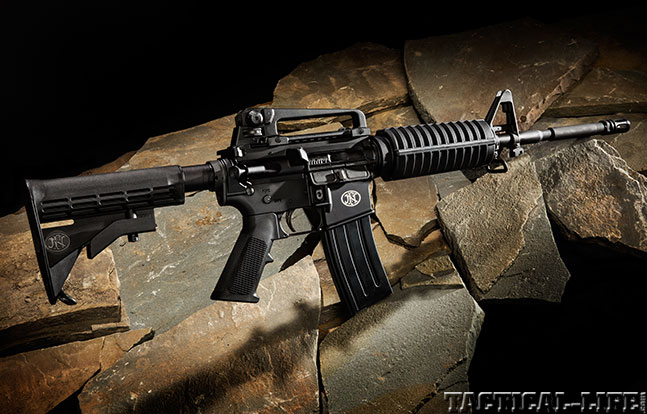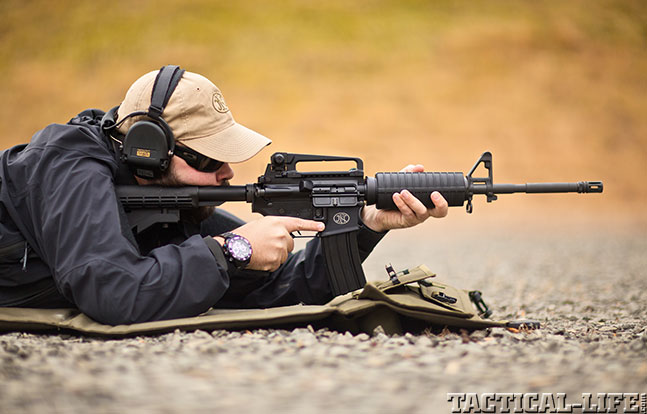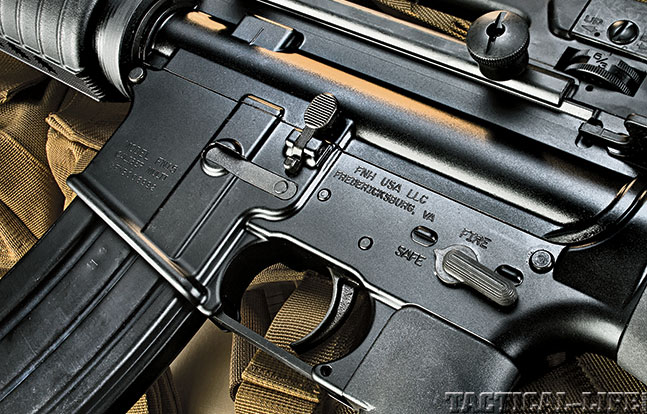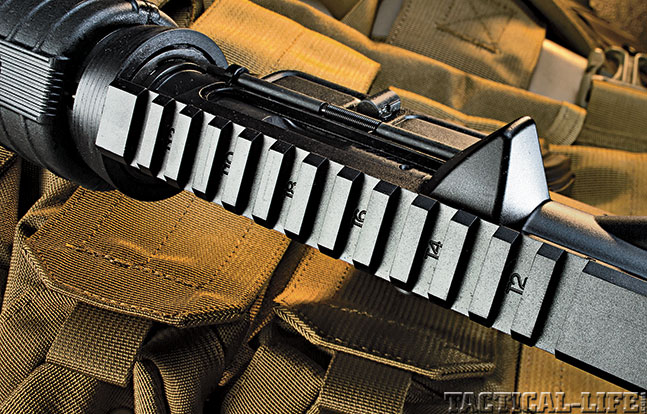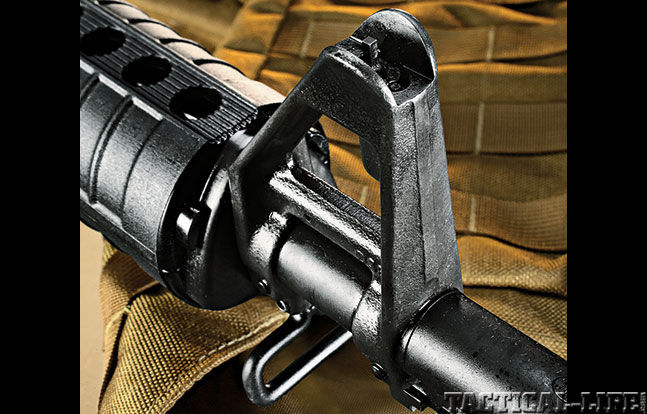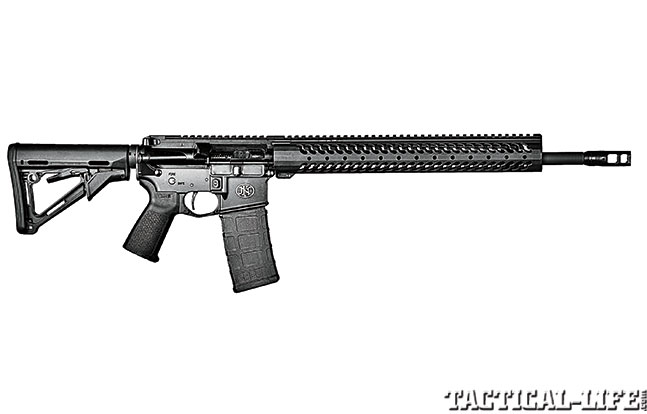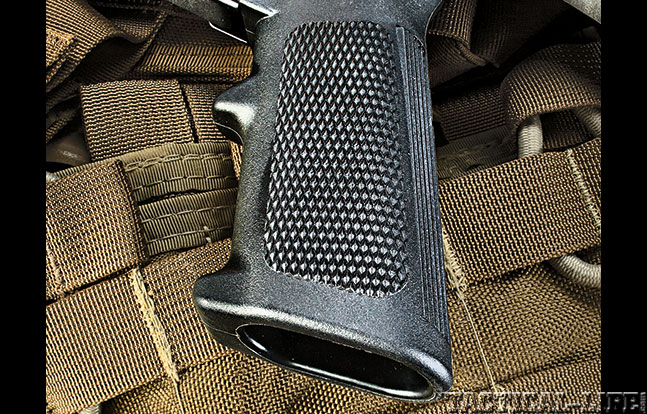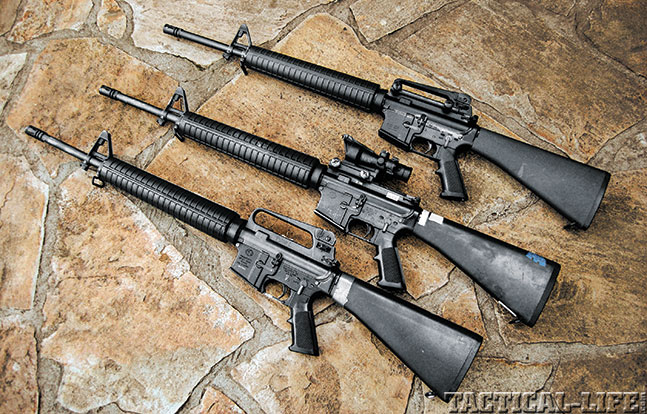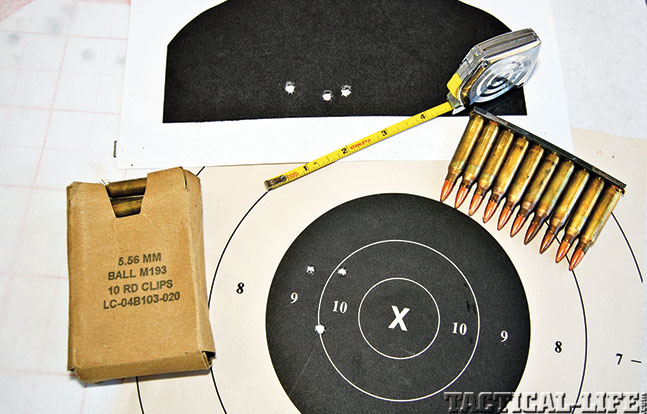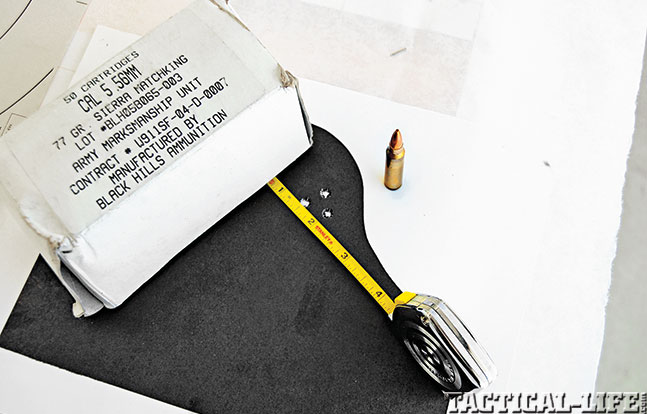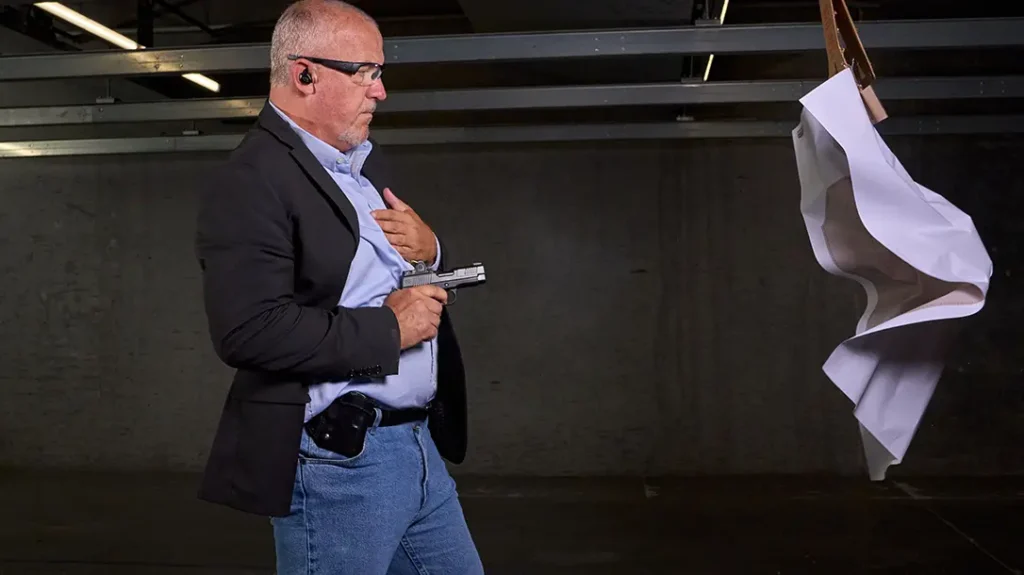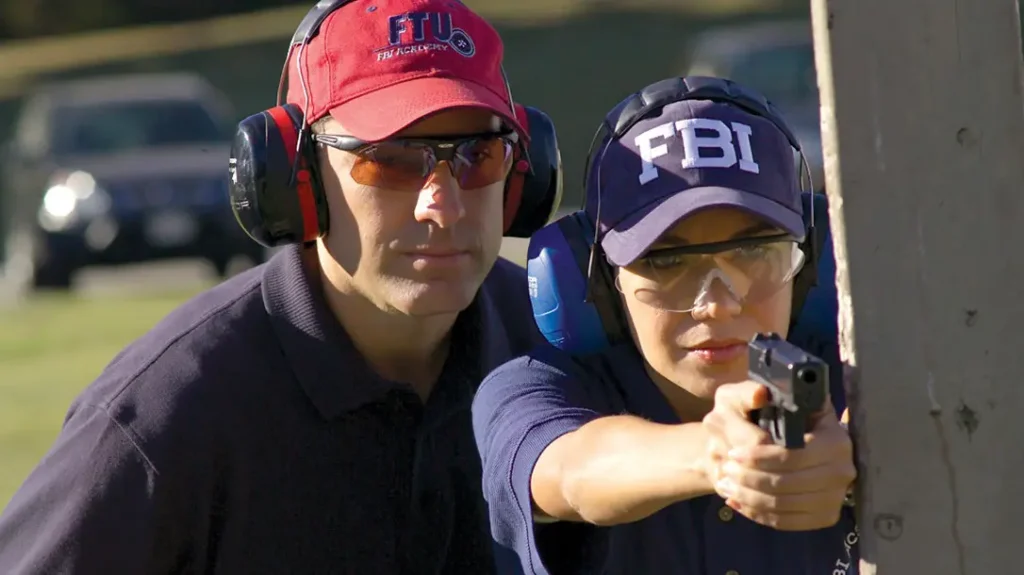New this year is the FN 15, a commercially released version of an AR-15 from FN America. Before passing this off as yet another AR-15, this is a model from more than just another maker. Despite the ever-increasing demand for these types of rifles in the civilian market, and the fact that FN has successfully released a number of designs for civilian consumers, it might be surprising that FN’s first version of the AR-15 intended for civilian sales is new this year. The company announced that it’s finally producing two models: a full-length, fixed-stock, A4-type rifle and a collapsible-stock M4 Carbine variant.
- RELATED: Watch FN America’s New Undercover FNS-40C
- RELATED: Sneak Peek: The FN America FN 15 Sporting Rifle
This has prompted some gun owners to ask if FN has experience building these rifles. The company has been producing AR-15s by the hundreds of thousands for decades, but until now FN has been more particular about its customer base. FN America remains the current manufacturer of the M16/M4 series for our Department of Defense. In addition, the company builds our current-issue machine guns based on its successful designs. In the early 1980s, the Department of Defense adopted FN’s Minimi (Mini Mitrailleuse, or “mini machine gun”) as the M249 and the legendary FN MAG (Mitrailleuse d’Appui Général, or “general-purpose machine gun”) as the M240. During this same period, FN also created the SS109 5.56x45mm cartridge, which was adopted as a standard NATO round and issued to the U.S. military as the M855. The company then opened FN Manufacturing in Columbia, S.C., to build small arms for the U.S. military. By the late 1980s, FN Manufacturing was selected to build the M16A2 and subsequent variants.
FN has been somewhat quiet about this, hence why some shooters have been wondering about FN’s experience with the AR-15. In fact, the company’s website makes no mention of the fact that FN America has been producing the M16/M4s presently in service with the U.S. military for many years.
Advertisement — Continue Reading Below
FN History
Fabrique Nationale d’Herstal (French for “National Factory of Herstal”), identified as FN Herstal or just FN, is an international small-arms manufacturer headquartered in Herstal, Belgium, and is one of the largest exporters of firearms in Europe. As is common in this industry, FN is a subsidiary of the Herstal Group, which also owns Browning and Winchester Repeating Arms. As mentioned, FN’s U.S-based production arm is FN America, with manufacturing in Columbia, South Carolina, and the sales and marketing branch located in McLean, Va. FN’s U.S. branch produces American-issue firearms, such as the M16 series, the M249 and the M240, among others.
Advertisement — Continue Reading Below
“These are the first true-to-issue AR-15s being made in the same south carolina facility that has been making issued M16/M4 series rifles since the late 1980s.”
Firearms designed and manufactured by FN at its U.S. plant include the FNX series of hammer-driven pistols, the FNS series of striker-fired pistols, the FN 15 series of AR-platform rifles, and the FN SPR and TSR bolt-action rifles. This is in addition to the company’s extensive line of military small arms. FN’s firearms are used by the armed forces of over 100 nations.
Advertisement — Continue Reading Below
Authentic AR
As mentioned, the newest addition to FN America’s line is the FN 15. This is arguably the most faithful copy of a government-issue rifle available for civilian sales, which makes sense as FN has been producing the 5.56mm M16 rifle under Colt license for a U.S. government contract since the late 1980s.
“FN’s years of experience manufacturing the M4 and M16 for the U.S. military have produced a commercial AR-15 that is mil-spec and much more.”
Advertisement — Continue Reading Below
The FN 15 is currently available in two versions. The FN 15 rifle has the same dimensions and features as the M16A4, with a 20-inch, 1-in-7-inch-twist, chrome-lined, alloy steel barrel featuring an A2-style flash suppressor and chambered in 5.56mm NATO. Like the M16A4’s issued sights, the FN 15 rifle comes with an A2-style front sight and a removable A4-style carry handle/rear sight. The standard, polymer forearm and fixed buttstock are both black, and its overall length is 39.5 inches. The FN 15 carbine is a similar build but with M4 dimensions, a 16-inch barrel and a six-position-collapsible stock. Its overall length is 31.9 inches with the stock collapsed and 35.2 inches with the stock completely extended.
Tactical Weapons has recently learned that FN America’s FN 15 carbine has already been selected as the official long arm of at least one large police department. The Killeen Police Department near Fort Hood, Texas, has procured and fielded 231 FN 15s. Shortly after FN America put the FN 15 to market, the Killeen Police Department put in a purchase for the carbine version with iron sights through TK Tactical. The police-issued FNs needed to be short and durable, and FN America President and CEO Mark Cherpes said Killeen went with the company because these officers needed “the standard benefits expected from an M4-style rifle.”
Advertisement — Continue Reading Below
Match Precision
Given that the FN 15 rifle has dimensions and specs identical to the current-issue M16A4, I decided to test it with three issued loads: the 62-grain, green-tip M855, the 55-grain M193 FMJ, and a 77-grain Sierra MatchKing round contracted by the U.S. Army Marksmanship Unit (USAMU) for Across The Course competitions. I assumed the FN 15 rifle would perform similarly to issued rifles, but I was pleasantly surprised.
I chose to use the included iron sights for all of the shooting instead of an optic because that is how these rifles are issued. Just like issued iron sights, the FN 15’s rear sight can be adjusted for windage and elevation in 0.5-MOA increments, and the front sight can be adjusted for elevation in 1.25-MOA increments. While a scope can certainly be an aid to good shooting, an optical sight doesn’t render the rifle more precise and, as decades of High Power and Long Range competition have proven, iron sights can be as accurate given an appropriate mark to aim at. I used B-8 pistol targets, which provide a nearly 6-MOA bull at 100 yards (the same size used in Across The Course matches) and reduced F-type “dog” silhouettes, which gave a flat, fat base to hold iron sights to.
Advertisement — Continue Reading Below
While shooting some initial groups at 50 yards after confirming I was on paper, I punched a neat half-inch triangle with three shots. Not a bad start. Moving to 100 yards gave similar results. More groups with the 77-grain load demonstrated that the initial group was not a fluke. I’ll be the first to admit that I’m not a particularly good rifle-shooter, but I found that shooting neat triangles just over an inch proved routine with this factory load in the FN 15. My group sizes averaged 1.25 inches for the day with the 77-grainers.
The M193 and M855 loads are noted for being less precise, but the FN 15 turned in good performance with this more commonly issued ammunition as well. The M193 ammo is usually more consistent, and that again proved to be the case. While not as precise as the superior 77-grain load, the FN 15 handled the 55-grain FMJ round quite well. These group sizes were, on average, only a few tenths of an inch larger. Shooting from the shoulder, especially from position, there are not many riflemen outside of top competitors who can benefit from that difference.
The worst group of the day, shot with M855 ball ammo, which is known for less-than-impressive precision, was just over 2 inches across. The best that my issued M16A2—which I’ve used at every All Army event I’ve competed in—has ever managed was a 1.88-inch group with this ammo, and that was from an expensive machine rest bolted to a concrete pillar. Despite being dimensionally identical to issued rifles, and as much as I’d like to trade my issued rifle for this FN 15, I would literally be cheating by using it at military shooting matches.
Advertisement — Continue Reading Below
Battle Legacy
FN’s years of experience manufacturing the M4 and M16 for the U.S. military have produced a commercial AR-15 that is mil-spec and much more. These are very basic AR-15s with the same configuration seen on issued rifles for over two decades. These are the first true-to-issue AR-15s being made in the same South Carolina facility that has been making issued M16/M4 series rifles since the late 1980s. If my test FN 15 is any indication, these are built better—or at least more accurate—than issued rifles. Word on the street is that these models are just setting FN up to be a major AR vendor in the civilian market.
Advertisement — Continue Reading Below
Even if that isn’t the case, sometimes basic and original is good. While walking down Commercial Row at Camp Perry this year, I saw at least one vendor offering parts for building replicas of Vietnam-era AR-15s, complete with pencil-thin barrels, three-pronged flash suppressors, triangle handguards and upper receivers without forward assists.
More important than nostalgia, the FN 15 is a great rifle to learn all the important points needed for effective riflery with a self-loading centerfire. It has all the adjustments required to learn slow and rapid fire at rifleman’s distances. One could argue that the M1 Garand or M14 is a better “real” rifle, but any sensible analysis shows the AR-15 has eclipsed them. Unless you pick it yourself in person at Perry or Anniston and know exactly what to inspect for, the CMP’s “Excellent” grade ($1,025 with shipping and a two-month wait) or better is the only way to ensure you’ll get a decent shooting rifle, and that will set you back the same amount as an FN 15. Even then, it’s still a used rifle and will certainly be more costly to feed. A decent M14 will be twice as much to buy and just as expensive with ammo. Unless you’re willing to dump more money into an M1 or M14, a factory-new FN 15 will almost certainly out-shoot them. There are reasons AR-15s dominate Across The Course Service Rifle events. Plus, should it be desired, the FN 15 sports a Picatinny rail, making it easy to add optics.
Sure, you can find plenty of vendors that will slap all sorts of gizmos on an AR-15 to entice sales. Unfortunately, that doesn’t make the shooter any better. Every skilled marksman and instructor worth listening to will advise all aspiring riflemen to stick to proven basics in an effort to improve their skills. Learn to shoot well with iron sights from position at varying distances and you’ll be effective with any small arm. A rifle like the FN 15 is ideal for all aspiring riflemen.
For more, visit fnhusa.com or call 703-288-3500.
Editor’s note: As this article went to press, TW editors learned that FN America is also announcing the introduction of its FN 15 Sporting variant, which should be a huge hit in the 3-Gun competition market. Be sure to check out video of the new FN 15 at tactical-life.com.
